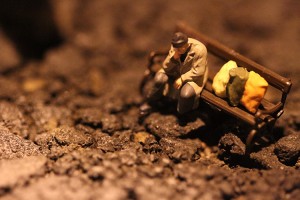Ted Chung: A Thousand Words
Ted Chung is a talented film director who grew up in the Chicago suburbs and went on to UCLA Film School, where he received the UCLA Directors Spotlight Award.
Chung demonstrates what excellent directing can achieve in a short film of less than five minutes. Simply using the camera, well integrated music, very well chosen actors and a fine understanding of visual communication, timing and nuances he is able to convey the character, feelings and emotions of the protagonists without the use of a single spoken word.
“A Thousand Words” and his film “Mike” are both shot very effectively in black and white. He elaborates:
” B&W is an immediate way of creating a style – especially when you’re shooting without many resources and can’t control the color scheme as much as you’d like. After shooting Mike’s and A Thousand Words in B&W, it was great being able to do On Time where everything was built or carefully sourced to align with an established color palette”
In an interview he explains the importance of music in his work:
“Music has a direct line to the subconscious, to emotion. Even a baby who doesn’t fully understand language yet can be emotionally influenced by a piece of music. It’s a very powerful tool in conveying feelings and ideas, but I think it’s important to have some restraint in how you deploy music. It’s often stronger to be more suggestive and give the audience space to fill with their own feelings. “
He was also selected for the Berlinale Talent Campus, where he directed On Time, a magical realism tale that premiered at the 58th Berlin Film Festival.
He is currently at work on his newest film, the sci-fi thriller I D.
“Ted Chung is one of my top five filmmakers on the web because he understands how to tell stories with or without words. The picture quality is irrelevant to his work. He uses screen direction and movement only when it is necessary to tell his story. He shows emotion and feeling in his characters, in his direction, and in the wonderful actors he casts. Most of the situations in his previous film involved lost chances and that’s some thing we all can intensely relate to. It is the moment that you are afraid, but you find the courage to take either the chance or not. Ted understands storytelling and that makes him a real filmmaker- Hollywood style,” says Director Steve Weiss.
Also directed by Ted Chung: “On Time“: http://vimeo.com/12947399
“Mike’s”: http://vimeo.com/16509726
tribecafilm.com/news-features/super_shorts/Super_Shorts_A_Thousand_Words.html
zacuto.blogspot.com/2009/12/steves-top-picks-for-2009.html
vimeo.com/album/159627/page:2 berlinale-talentcampus.de/campus/talent/ted-chung zacuto.com/featured-filmmaker-ted-chung
“An elegant and very affecting portrait of big-city loneliness and the instant connections that go “ping” and are gone seconds later. The emotions are halting, delicate, true.” -Jeffrey Wells, Hollywood Elsewhere
Read MoreSeed Story
 As a lone dandelion blossoms in an abandoned parking lot, it divides the lives of several miniature people in this experimental narrative short film by award winning film maker William D. Caballero.
As a lone dandelion blossoms in an abandoned parking lot, it divides the lives of several miniature people in this experimental narrative short film by award winning film maker William D. Caballero.
Filmed in an abandoned parking lot, using a cast of carefully painted tiny model figures this experimental film focuses on the destructive addictions humanity has suffered through the ages.
The film looks at the role of religion, capitalism, environmentalism and fascism through the perspective of macro photography.
Shooting took place over two months in the Summer of 2012, on a budget of less than$3,000. Torches, sparklers and smoke guns were used to create special effects.
Shooting was done close to the ground, during both days of 90 degree heat and heavy rainstorms. The biggest disruption proved to be breezes that at times blew entire sets away.
 Directed and conceived by William D. Caballero, it premiered at the 2013 Slamdance Film Festival and at numerous festivals across the world.
Directed and conceived by William D. Caballero, it premiered at the 2013 Slamdance Film Festival and at numerous festivals across the world.
As of April, 2013, SEED STORY has screened or will screen at numerous film festivals, including a world premiere at the SLAMDANCE FILM FESTIVAL in January, 2013. The festival had a less than 2% acceptance rate making entry into it more competitive than entry into Harvard!
AWARDS:
VANGUARD AWARD (for directors who are pushing the boundaries of experimental/non-linear film) at the 2013 ART OF BROOKLYN FILM FESTIVAL!
BEST SOUND DESIGN at the 2013 VISIONFEST
BEST SHORT FILM (Honorable Mention) at the 2013 PHILADELPHIA INDEPENDENT FILM FESTIVAL
OFFICIAL SELECTIONS
- VIMEO STAFF PICK
- SLAMDANCE FILM FESTIVAL
- ATLANTA FILM FESTIVAL
- RxSM FILM EXPO
- PHILADELPHIA INDEPENDENT FILM FESTIVAL
- VISIONFEST
- KAHBANG FILM FESTIVAL
- ART OF BROOKLYN FILM FESTIVAL
- VICTORIA TEXAS INDEPENDENT FILM FESTIVAL
- XICAN INDIE FILM FESTIVAL
- INDIANAPOLIS INTERNATIONAL FILM FESTIVAL
- GUANAJUATO INTERNATIONAL FILM FESTIVAL
- PORTLAND UNDERGROUND FILM FESTIVAL
- HARLEM INTERNATIONAL FILM FESTIVAL
More to come!
To see a new short film consisting of deleted scenes from Seed Story, click here: vimeo.com/74943004
The film below was created using deleted scenes from the Seed Story film.
For more information on the project, visit wilcab.com/seedstory/
Directed, produced, shot, edited, animated, and scored by William D. Caballero
“Special thanks to the art crew and production team. I couldn’t have done it without you.”
Gasland, the Fracking Truth
It’s amazing that what took mother nature millions of years to buid can be destroyed in a few hours with heavy machinery” – Josh Fox
Gasland: The Movie
“The largest domestic natural gas drilling boom in history has swept across the United States. The Halliburton-developed drilling technology of “fracking” or hydraulic fracturing has unlocked a “Saudia Arabia of natural gas” just beneath us.
When filmmaker Josh Fox is asked to lease his land for drilling, he embarks on a cross-country odyssey uncovering a trail of secrets, lies and contamination. A recently drilled nearby Pennsylvania town reports that residents are able to light their drinking water on fire. This is just one of the many absurd and astonishing revelations of a new country called GASLAND. Part verite travelogue, part expose, part mystery, part bluegrass banjo meltdown, part showdown.”
Gasland- Reviews (at bottom of page)
The Oil Industry has tried to discredit the film and the issues it raises via a disinformation campaign, including a video in direct response to the film .
Gasland replied to its accusations in detail on its website.
Green MP Caroline Lucas Arrested in Fracking Protest
Why would Green Party Member of Parliament be willing to face arrest in order to demonstrate against the process of fracking in the UK?
Caroline Lucas, the MP for Brighton Pavilion said:
“Along with everyone else who took action today, I’m trying to stop a process which could cause enormous damage for decades to come. People today, myself included, took peaceful non-violent direct action only after exhausting every other means of protest available to us.
Despite the opposition to fracking being abundantly clear, the government has completely ignored the views of those they are supposed to represent. When the democratic deficit is so enormous, people are left with very little option but to take peaceful, non-violent direct action.”
The Department o Energy and Climate Change did not respond to requests for comment on the protests.
When one reads documentation concerning the effects of Fracking and the Oil Industry on human health and the environment, it becomes very clear why this issue is one worth protesting about.
THE ENDOCRINE DISRUPTION EXCHANGE
“To date, no chemical in use has been thoroughly tested for its endocrine disrupting effects. Traditional toxicological testing protocols were not designed to test for endocrine disruption and to test at ambient or low exposure levels.”
The Endocrine Disruption Exchange is one of the few organisations that has studied the effects of products and chemicals used in the Oil/Gas industry.
Its findings are very disturbing.
Extract:
T he technology to recover natural gas depends on undisclosed types and amounts of toxic chemicals.
A list of 944 products containing 632 chemicals used during natural gas operations was compiled. Literature searches were conducted to determine potential health effects of the 353 chemicals identified by Chemical Abstract Service (CAS) numbers.
-
More than 75% of the chemicals could affect the skin, eyes, and other sensory organs, and the respiratory and gastrointestinal systems.
-
Approximately 40-50% could affect the brain/nervous system, immune and cardiovascular systems, and the kidneys;
-
37% could affect the endocrine system; and
-
25% could cause cancer and mutations.
-
These results indicate that many chemicals used during the fracturing and drilling stages of gas operations may have long-term health effects that are not immediately expressed.
- In addition, an example was provided of waste evaporation pit residuals that contained numerous chemicals on the Comprehensive Environmental Response, Compensation, and Liability Act (CERCLA) and Emergency Planning and Community Right to Know Act (EPCRA) lists of hazardous substances.
- The discussion highlights the difficulty of developing effective water quality monitoring programs.
- To protect public health we recommend full disclosure of the contents of all products, extensive air and water monitoring, coordinated environmental/human health studies, and regulation of fracturing under the U.S. Safe Drinking Water Act.
Extracting, processing, and burning fossil fuels (natural gas, oil and coal) introduces huge volumes of harmful chemicals into our environment. These chemicals, and the tens of thousands of chemical products synthesized from them, are now present in every environment on earth, including the womb. Extremely low concentrations of many chemicals can damage the endocrine system of our bodies by interfering with the intricate, delicate network of natural chemical interactions critical to healthy development and normal function.
n 1991, an international group of experts stated, with confidence, that “Unless the environmental load of synthetic hormone disruptors is abated and controlled, large scale dysfunction at the population level is possible.”
They could not perceive that within only ten years, a pandemic of endocrine-driven disorders would begin to emerge and increase rapidly across the northern hemisphere. Today, less than two decades later, hardly a family has not been touched by Attention Deficit Hyperactivity Disorder, autism, intelligence and behavioral problems, diabetes, obesity, childhood, pubertal and adult cancers, abnormal genitalia, infertility, Parkinson’s or Alzheimer’s Diseases.
TEDX’s findings confirm that each of these disorders could in part be the result of prenatal exposure to chemicals called endocrine disruptors. TEDX has also confirmed that the feed stocks for most endocrine disrupting chemicals are derived from the production of coal, oil, and natural gas. It is clear that endocrine disruption, like climate change, is a spin-off of society’s addiction to fossil fuels. Setting aside the effects of endocrine disruptors on infertility, and just considering their influence on intelligence and behavior alone, it is possible that hormone disruption could pose a more imminent threat to humankind than climate change
Fracking and Hazardous Waste
Many people and animals have fallen ill since fracking started in their area. The process of fracking pumps toxic chemicals at high pressure into the earth in order to cause minor earthquakes that loosen deposits of natural gas that have been trapped in the rock for millions of years. The process threatens to pollute groundwater and an estimated 30% to 70% of poisoned water is estimated to resurface and continue to surface for the life of the well (20 – 30 years)
Why is this Allowed?
Many of the chemicals used in the process of fracking are considered hazardous waste.
Why are these toxins being allowed to be pumped into the earth all over the USA when they are a real danger to drinking water supplies?
“In his second week in office, George W. Bush created the energy task force, officially known as the
National Energy Policy Development Group, with Vice President Dick Cheney as chairman. In
its mission, NEPDG aimed to: “develop a national energy policy designed to help the private
sector. . . .”
Only when pressed by EPA chief Christie Todd Whitman did Cheney remove a recommendation to
exempt fracturing from the task force’s final report. Whereupon, the Bush/Cheney Energy Bill of
2003 included a provision to exempt fracturing from EPA drinking water regulation — but Congress
removed the provision from the final draft.
Whereupon, in the Energy Policy Act of 2005, Congressmen James Inhofe of Oklahoma and Joe
Barton of Texas inserted language to:
“Amend the Safe Drinking Water Act of 1996 to exempt
hydraulic fracturing related to oil and gas production . . . and, thus, exclude this practice from . . .
regulations related to the protection of underground sources of drinking water.”
– Steve Coffman (on Gasland’s official reply to the Gas Industry’s attempt to discredit the film.)
BBC Horizon Documentary on Fracking
The BBC Program: Horizon made a documentary examining the process of Fracking which questions whether there were indeed (as the Oil/Gas companies would have us believe) no risks involved to people living near the the Fracking wells.
Communities did appear to be experiencing high levels of illness. It seemed strange that so little was understood about the causes of the illnesses. One factor may have been that many people had received compensation and had signed gagging clauses which did not allow them to discuss their situation.
Plenty of people did seem willing to talk about afflictions to themselves and animals in the area that appeared since fracking began.
The reason for lack of clarity about the cause became apparent when the rights of industry to avoid transparency was raised.
Money is More Important than the Health of USA Citizens.
Drilling companies in the USA are allowed to keep the chemicals used in their procedures a secret, even when they may be causing a health risk. This makes it almost impossible for people to know what might have be causing the illnesses that have occurred since the fracking began in their areas.
Medical doctors have managed to get special permission to be request this information from the companies.
Doctors Can’t Tell Their Patients
One doctor has treated people with leisions to their faces that she thinks might be related to chemicals from fracking . The drilling companies only allow her access to the information about chemicals they use, under the strictest of conditions. They insist the doctors sign a confidentiality statement which means they are unable to tell their patients what they have discovered are causing their illnesses.
If a doctor (that has been given the information about the chemicals) has now been able to diagnose the cause of the medical problem decides they need to refer the patient to another medical specialist, they are not allowed to pass on the information to the other doctor or medical specialist.
“for physicians in order to take care of your patients, there needs to be transparency and this completely breaks that down, so yes it’s very upsetting for us because we want people to get better, but if you can’t explain to someone what’s happening to them, how do you get them better… and then how do you find out if other members of their family may have been exposed .. or other people in the area may have been exposed because no one can talk about it. So it really goes against any type of modern medicine“
Reviews of Gasland
Robert Koehler of Variety referred to it as “one of the most effective and expressive environmental films of recent years… Gasland may become to the dangers of natural gas drilling what Silent Spring was to DDT.”[18]
Eric Kohn of IndieWire wrote, “Gasland is the paragon of first person activist filmmaking done right… By grounding a massive environmental issue in its personal ramifications, Fox turns Gasland into a remarkably urgent diary of national concerns.”[19]
Stewart Nusbaumer of the Huffington Post wrote “Gasland… just might take you from outrage right into the fire of action.”[20]
Gasland currently holds a 97% rating on the film site Rotten Tomatoes based on 37 reviews.[21] Mark Kermode of BBC Radio 5 Live gave it a generally positive review, criticizing its similarity to other recent oil documentaries, yet praising its “extraordinary visual kick”. He said “it is a very interesting story which is made better by the fact that the visuals of it are very poetic, very lyrical”, and felt that its themes and ideas were relevant and well presented.
The Denton Record Chronicle said “Fox decides that his own backyard in Pennsylvania isn’t his exclusive property… Set to his own banjo music and clever footage, Gasland is both sad and scary… if your soul isn’t moved by the documentary, yours is a heart of shale.”[22]
Bloomberg News critic Dave Shiflett wrote that Fox “may go down in history as the Paul Revere of fracking.”[23]
Chicago TimeOut gave Gasland four out of five stars.[24]
In Australia, film critic Julie Riggs called the documentary a “horror movie, and a wake-up call.”[25][26]
Fort Worth Business Press writer John-Laurent Tronche talks about the growing number of documentaries “that aim to shed a light on what they call a dirty, destructive practice: shale gas exploration. And although oil and gas supporters have labeled the motion pictures as radical propaganda, a local drilling activist said they’re part of a larger, critical look into an ever-growing industry.”[27]
Read MoreMandela Day: You are The Power of Change
Mandela Day is an international day in honour of Nelson Mandela,
celebrated annually on the 18th of July – Mandela’s Birthday.
It is a call to action for individuals – for people everywhere –
to take responsibility for changing the world into a better place,
one small step at a time, just as Mr Mandela did.
Following the success of Nelson Mandela’s 90th birthday celebrations in London’s Hyde Park in June 2008 and the 4664 concerts, it was decided that there could be nothing more fitting than to celebrate Mr Mandela’s birthday each year with a day dedicated to his life’s work and that of his charitable organisations, and to ensure his legacy continues forever.
The day was officially declared by the United Nations in November 2009. Mandela Day is not meant as a public holiday but is a global call to action that celebrates the idea that each individual has the ability to make an impact and the power to transform the world.
The Mandela Day campaign message is simple: Mr Mandela gave 67 years of his life fighting for the rights of humanity. All we are asking is that everyone gives 67 minutes of their time, whether it’s supporting your chosen charity or serving your local community.
Long Road to Freedom
On August 5th, 1962, an ordinary piece of road along the R103 about 3 kilometres outside Howick in KwaZulu-Natal took on extraordinary significance when armed apartheid police flagged down a car.
The man pretending to be the chauffeur had earned the nickname of the “Black Pimpernel” having evaded capture by the apartheid regime for 17 months. It was in this dramatic manner at this unassuming place that Nelson Mandela was finally captured and was to disappear from public view for the next 27 years.
Mandela had just paid a clandestine visit to ANC President Chief Albert Luthuli to report on his African Odyssey. His meeting was also to request support for an armed struggle, after having spent most of his adult life trying to find peaceful ways in which to end the injustice and suffering caused by the system of Apartheid in South Africa, without success.
50 years later on August 4th 2012, to mark the anniversary of the start of Nelson Mandela’s “long walk to freedom” a quietly powerful new sculpture was inaugurated and unveiled at this spot.
The sculpture is comprised of 50 steel column constructions, each between 6.5 and 9.5 meters tall, set into the landscape of the Natal Midlands. The posts are staggered and the portrait of Nelson Mandela only comes into correct focus when the posts line up at a position 35 meters from the sculpture (a reference to the fact that Mandela proved notoriously difficult for the authorities to find).
From this perspective the sculpture reads as a familiar photograph of Mandela, suggestive of his incarceration as one is aware it is comprised essentially of a series of steel bars, but seen from other angles the design splinters into a dynamic moment of fracture and release.
The artist Marco Cianfanelli comments on the deliberate structural paradox, that, “this represents the momentum gained in the struggle through the symbolic of Mandela’s capture. The 50 columns represent the 50 years since his capture, but they also suggest the idea of many making the whole; of solidarity. It points to an irony as the political act of Mandela’s incarceration cemented his status as an icon of struggle, which helped ferment the groundswell of resistance, solidarity and uprising, bringing about political change and democracy”.
http://www.mandela-children.org.uk/
Read MoreFiddle Oak: Welcome to my World
The profoundest thought or passion
sleeps as in a mine,
until an equal mind and heart
finds and publishes it.
— Ralph Waldo Emerson —
Have you ever looked at a beautiful lichen covered rock with wild-flowers dropping pollen on it, and wished you could find a landscape as lovely to step into?
With a bit of imagination you can, as
Fiddle Oak demonstrates in his photograph: “The Melody”
Inspiration may come on a calm evening spent sharing
Summer Tales with a friend:
.. Or even arrive with tomorrow’s dinner.
Fiddle Oak: Travels with Betsy and Diana
This magical journey is brought to you by a 14 year old photographer who lives in a suburb of Boston and is home-schooled by his mother who is a sculptor.
Zev Hoover was eight when he started taking photos on his mobile phone for fun. His mother saw the potential he was showing and bought a point and shoot camera for him on eBay. It wasn’t long before she bought him a better one. And then an even better one.
He now has two cameras, both which he has named. He calls his still camera “Betsy” and his video camera is “Diana”.
“I like naming things,” he says. “My bike is named Patrick.”
The youngest in a family, with four siblings ,he gives his older sister Nell credit for helping with some of the ideas for the images he creates. She suggested the idea of images of little folk and he came up with the name of Fiddle Oak as his Flickr name, a play on the words.
“My sister is more of a writer, but she is sort of my partner in crime,” he says. “I do the actual work with the camera and edit the picture, but she helps with a lot of the concepts.”
He describes the process of creating the images:
“I shoot what I call the background — the scene, without props, first. Often it’s a collage of multiple pictures. Then I try to match the lighting of that picture and take pictures of people in the right position to be in the pictures, then I shrink them in Photoshop and change the colors so they match the background a little bit better, then I do overall color editing to make them match. It takes a long time.”
Thanks to Sail for sharing this story .
Read More







